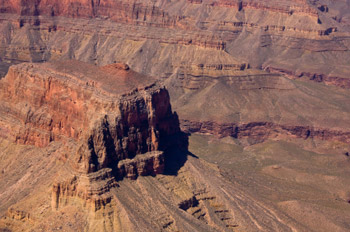Family Field Trip: The Grand Canyon
More than five million people are drawn to the Grand Canyon in Northern Arizona each year. This breathtaking geological wonder, which earned National Park status in 1919, can provide your child with a memorable and enlightening lesson in geology on a massive scale.

 |
Before You Go
The most awe-inspiring facet of the Grand Canyon is the scale of its erosion by the Colorado River. Before you take your child there, you can teach him or her about erosion by conducting simple science experiments at home. A small-scale project can help your child understand the forces that carved the Grand Canyon.
To start, take any dry kitchen item, such as flour, rice or coffee grounds, and pack it into a mound on a rimmed cookie sheet. Have your child pour water onto the top of the mound and note how the water carves rivulets into its sides. As more water is poured, note how the mound begins to deteriorate along the path of the water.
This erosion experiment can be taken outside. You can conduct the same experiment using a packed pile of dirt or sand. A rain shower will provide evidence of how these forces naturally occur. If you live near a stream or river, have your child look for signs of erosion along the banks; this may include areas where plants have washed away, exposing different colors of dirt or clay.
 |
Teaching Moments at the Site
Visiting the Grand Canyon offers your child the opportunity to understand geological processes in a spectacular setting. The deep canyon and winding river allow bountiful chances to study how time and water can drastically impact the land. You may start by having your child study the layered rocks in the canyons. The canyon walls, which extend to 6,000 feet deep, provide evidence of the Earth's history going back approximately two billion years and representing three of the four eras of geological time.
There are numerous rock types your child can look for throughout the Grand Canyon. These include sedimentary, igneous and metamorphic rocks. Most of what can be easily viewed is sedimentary rock. Your child may be able to identify layers of sandstone, shale and limestone in the sedimentary walls. Look for areas where the horizontal layers are broken up or tilted, suggesting magma intrusions or other geological events.
The Ride Home
After visiting the Grand Canyon, have your child complete a journal. This journal can include photos of the canyon your child took during the trip. It may also include drawings of the rock layers and other sights he or she found interesting. The journal can become a lasting record of the visit that enables your child to quickly refer back to what you saw and remember the power of erosion and the fascinating study of geology.
Other Articles You May Be Interested In
-
Tips for Incorporating Technology and Multimedia Into Lesson Plans

Technology is becoming an increasingly relevant part of students' lives. This article discusses ways to best utilize technology and multimedia elements in the classroom.
-
Tips for Finding Help When Developing Lesson Plans

Teachers often find themselves altering and adapting their lesson plans to the ever changing curriculum standards. This article discusses ways to make changing and developing lesson plans less stressful.
We Found 7 Tutors You Might Be Interested In
Huntington Learning

- What Huntington Learning offers:
- Online and in-center tutoring
- One on one tutoring
- Every Huntington tutor is certified and trained extensively on the most effective teaching methods
K12

- What K12 offers:
- Online tutoring
- Has a strong and effective partnership with public and private schools
- AdvancED-accredited corporation meeting the highest standards of educational management
Kaplan Kids

- What Kaplan Kids offers:
- Online tutoring
- Customized learning plans
- Real-Time Progress Reports track your child's progress
Kumon

- What Kumon offers:
- In-center tutoring
- Individualized programs for your child
- Helps your child develop the skills and study habits needed to improve their academic performance
Sylvan Learning

- What Sylvan Learning offers:
- Online and in-center tutoring
- Sylvan tutors are certified teachers who provide personalized instruction
- Regular assessment and progress reports
Tutor Doctor

- What Tutor Doctor offers:
- In-Home tutoring
- One on one attention by the tutor
- Develops personlized programs by working with your child's existing homework
TutorVista

- What TutorVista offers:
- Online tutoring
- Student works one-on-one with a professional tutor
- Using the virtual whiteboard workspace to share problems, solutions and explanations